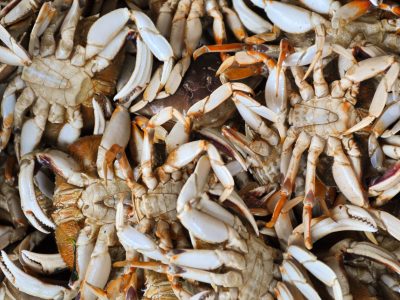Bottlenose Dolphin
Tursiops Truncatus
Stays in groups from 15 to 2,000 in number!'
Advertisement
Bottlenose Dolphin Scientific Classification
- Kingdom
- Animalia
- Phylum
- Chordata
- Class
- Mammalia
- Order
- Cetacea
- Family
- Delphinidae
- Genus
- Tursiops
- Scientific Name
- Tursiops Truncatus
Read our Complete Guide to Classification of Animals.
Bottlenose Dolphin Conservation Status
Bottlenose Dolphin Facts
- Main Prey
- Fish, Crustaceans, Squid
- Distinctive Feature
- Large dorsal fins and communicate using whistling
- Habitat
- Harbors, Bays, Gulfs, Coastal Waters
- Predators
- Human, Sharks, Killer Whale
- Diet
- Carnivore
- Average Litter Size
- 1
- Lifestyle
- Pod
- Favorite Food
- Fish
- Type
- Mammal
- Slogan
- Stays in groups from 15 to 2,000 in number!'
View all of the Bottlenose Dolphin images!
The bottlenose dolphin is one of nature’s most intelligent species
The bottlenose dolphin is a well-known species of dolphin that lives across the world and is known for its incredible intelligence. Bottlenose dolphins are one of the few species that have demonstrated self-recognition and have a highly developed spoken language that scientists believe closely resembles human communications.
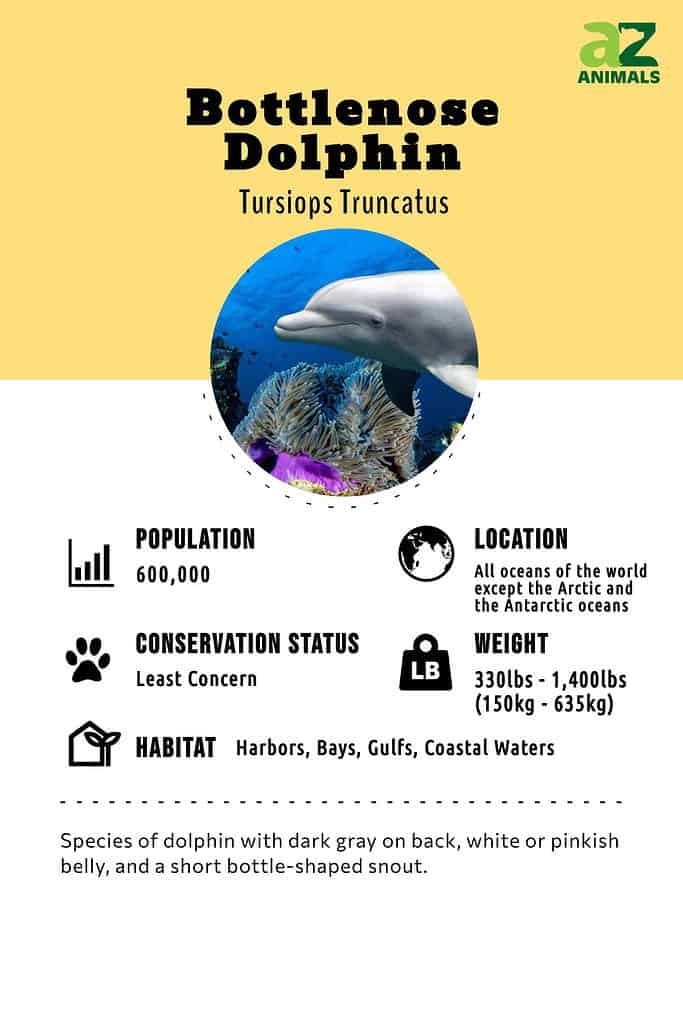
Incredible Bottlenose Dolphin Facts!
- Bottlenose dolphins are so intelligent that in some locations they’ve learned to hunt with humans! In the town of Leguna, Brazil they’ve been cooperating with local fishermen to hunt since 1847!
- Bottlenose dolphins are believed to have the longest memory of all non-human species. Scientists from the University of Chicago discovered dolphins can recognize whistles from their mates after being separated for more than 20 years!
- Bottlenose dolphins have been observed changing how they communicate to a “common language” when they encounter other dolphin species.
Scientific Name
The scientific name of the common bottlenose dolphin is Tursiops truncatus. This is derived from tursio, which describes a fish that looks like a dolphin. “Ops” means the dolphin looks like this fish, which was first described by Pliny, the ancient Roman historian. Truncatus describes the animal’s short beak.
Other names for the dolphin are the bottlenose porpoise, the common porpoise, the black porpoise, or the gray porpoise, even though it’s not a porpoise at all. A porpoise is another aquatic mammal found in an entirely different family.
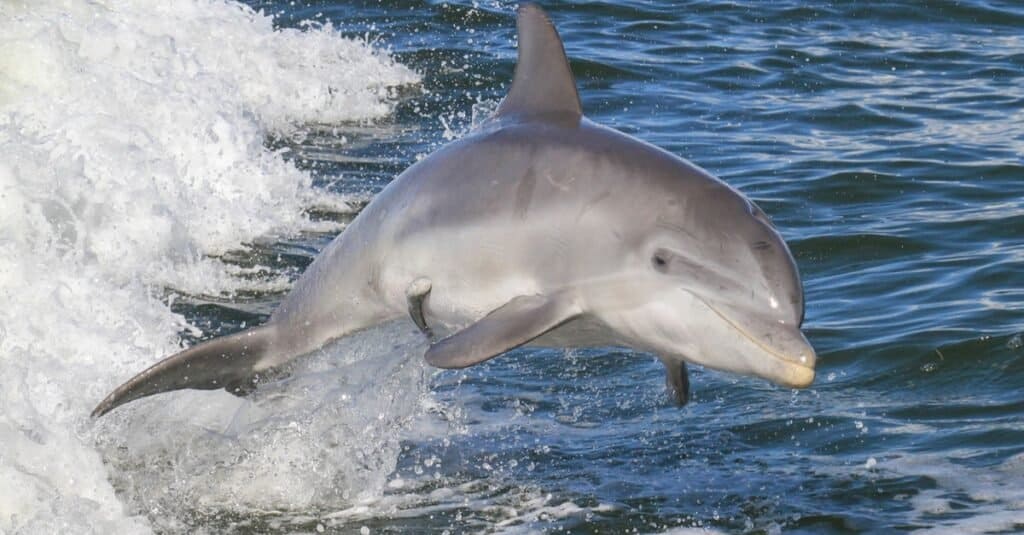
©Tory Kallman/Shutterstock.com
Evolution
Scientists believe that dolphins are descended from four-legged land-dwelling ancestors–possibly the Pakicetus, which lived 50 million years ago. As these creatures spent more and more time in the water, their bodies evolved, losing their land-living abilities and adapting to aquatic living. The mid-stage animals which were semi-aquatic include the Protocetids, while the first known animals to live exclusively in water are the Durudon and Basilosaurus, around 38 million years ago.
In the early Miocene Era, dolphin-like animals inhabited oceans. They were cetaceans with mid-sized teeth in the family Kentriodontidae, fed on small fish, and were echolocators.
Five million years ago, the genus Tursiops appeared from which the bottlenose dolphin belongs.
Classification and Taxonomy – Types of Bottlenose Dolphin
The taxonomy of bottlenose dolphins has been under debate in the scientific community. Today, the IUCN (the organization that determines whether species are endangered) recognizes two species of bottlenose dolphins.
- Common bottlenose dolphin (Tursiops trunatus): the most commonly found bottlenose dolphin found in temperate waters across the world.
- Indo-Pacific bottlenose dolphin (Tursiops aduncus): A species found in the Indian Ocean and waters off China and Australia which has a dark-grey color and is generally smaller than common bottlenose. It was first recognized as a separate species in 1998.
Finally, in 2011 researchers in Australia published research that a third species of bottlenose dolphin existed. They named it the Burrunan dolphin. The species lives in a small geographic area near Melbourne and as few as 150 individuals in the species may survive.

The two main types of bottlenose dolphins are the Common and the Inco-Pacific bottlenose dolphin.
©grafxart/Shutterstock.com
Appearance and Behavior
The bottlenose dolphin grows to about 12 feet long (3.5 m), though smaller individuals can be only about 6.6 feet long (2 m). It can weigh between 300 and 1400 pounds (135 to 635 kg), and males are usually bigger than females. Sometimes they weigh twice as much. Biologists believe this is because females become mature at an earlier age, which takes a lot of energy. Males keep growing until they become mature.
The bottlenose dolphin has a robust body that’s dark gray on the back and lighter gray on the sides. The belly is white or even a bit pinkish, though the color of individual animals can range from nearly black to albino. Some dolphins have what looks like a cape over their heads, and older females can have spotted bellies.
The beak that gives the dolphin its scientific name is indeed short and bottle-shaped, and there’s a groove between the snout and the dolphin’s forehead. The fin on the animal’s back is near its center. It is broad at the bottom and has a pointed tip. Since dolphins don’t chew their food, they have multiple stomachs to aid in digestion. While most dolphins have three stomachs, some have two.
Bottlenose dolphins swim in pods. These pods usually have about 15 dolphins, but a pod can range from just two dolphins to over 1000 that come together briefly. Dolphins use echolocation to find food. This echolocation is so precise it can not only tell the dolphin where the prey is but its shape. Sometimes the echolocation is so powerful that it stuns the prey. At other times, the dolphin simply listens to find its food.
Bottlenose dolphins use a great number of sounds to communicate with each other, including squeaks and whistles. There is a type of oil in their heads that helps amplify sound waves. The dolphins also use their bodies to communicate. Slapping its tail on the water is often a sign the animal is angry about something. They can also stroke and caress each other and come to each other’s aid when they’re injured.
Like humans, bottlenose dolphins often do things simply for fun. They ride the bow waves of boats or even surf and leap out of the water. Sometimes, their curiosity makes them approach humans so closely that the human can reach out and touch them.

©slowmotiongli/Shutterstock.com
Habitat
Bottlenose dolphins are found in warmer waters around the world. They are not often found in the polar regions. They live in estuaries where rivers meet the ocean, shallow bays, and even freshwater rivers and other bodies of water close to the shore. Some pods can also be found offshore in deep water. The dolphins that live offshore are bigger and darker than those that live inshore and have been known to migrate as much as 2600 miles in a season while inshore pods have been known to migrate during El Niño events.
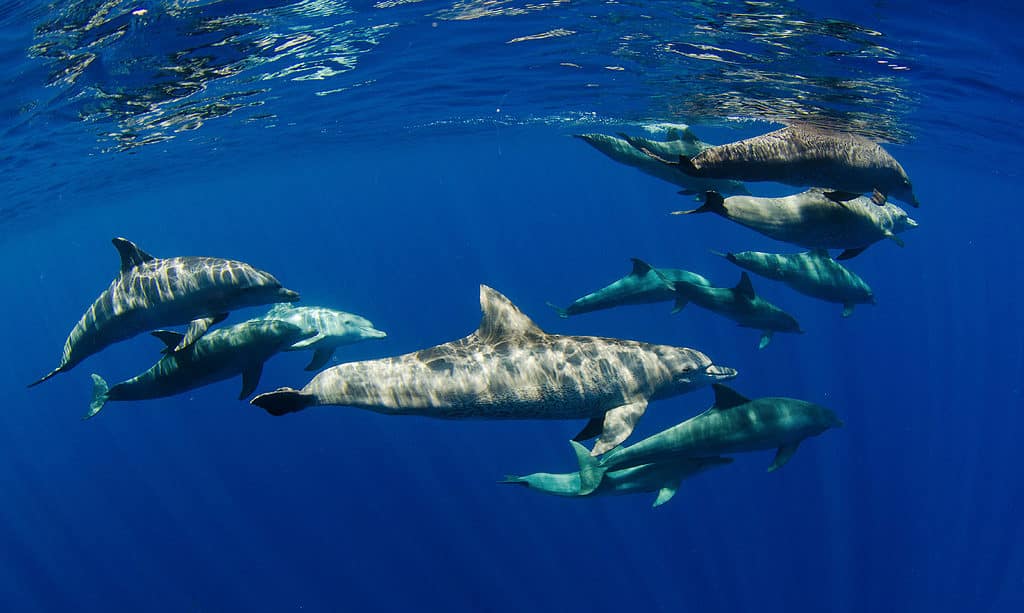
Bottlenose dolphins live in estuaries, shallow bays, and even freshwater rivers and other bodies of water close to the shore.
©Joost van Uffelen/Shutterstock.com
Diet
Bottlenose dolphins eat a great variety of seafood, including fish, shrimp, crabs, and squid. They love to follow fishing boats and grab the unwanted fish that’s tossed overboard, though this risks the dolphin getting tangled in the nets. If the dolphin can’t free itself and come up for air, it will drown. Other dolphins can be fatally injured if they swallow fish hooks.
Though bottlenose dolphins have teeth, they use them to hold on to their prey. They don’t chew but swallow prey whole. Pods sometimes come together to hunt.
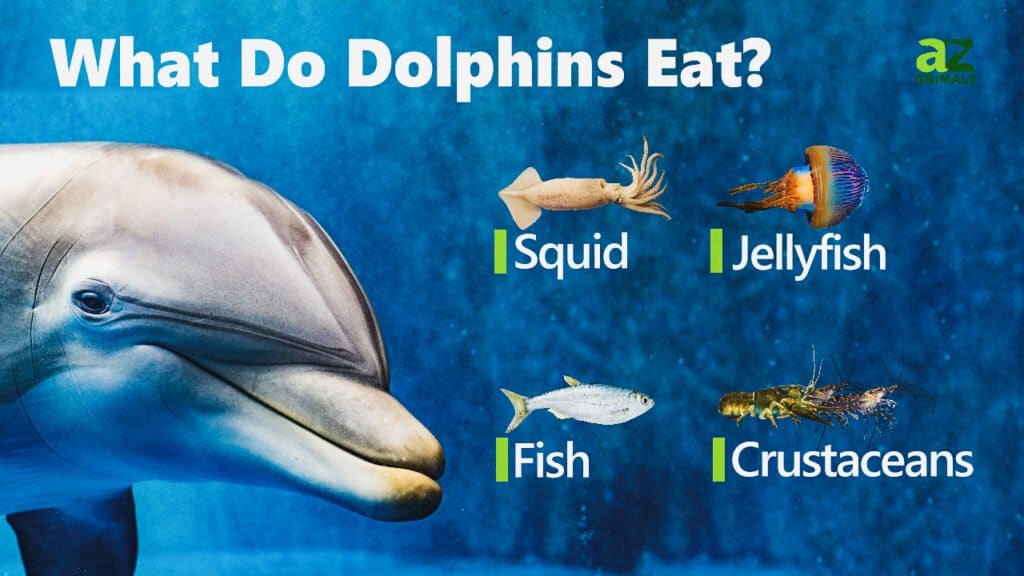
Predators and Threats
The primary predators and threats to bottlenose dolphins are humans and big sharks such as bull sharks and tiger sharks. While bottlenose dolphins aren’t often deliberately hunted for food, they can be tangled in large fishing nets. In addition, they face threats like pollution, oil spills, and development around estuaries and areas they congregate. For example, fertilizers and contaminants released into water deplete the water of its oxygen and can cause blooms of poisonous algae. When the dolphins eat the fish that live in these polluted waters, they get sick and sometimes die. Just swimming through contaminated waters also causes dolphins to sicken.
Sharks such as the tiger and bull shark are especially partial to smaller dolphins, including babies and females. It’s not unusual to see a dolphin with scars from the bite of a shark. Biologists believe they survive thanks to their blubber. Stingrays have also been known to kill bottlenose dolphins.
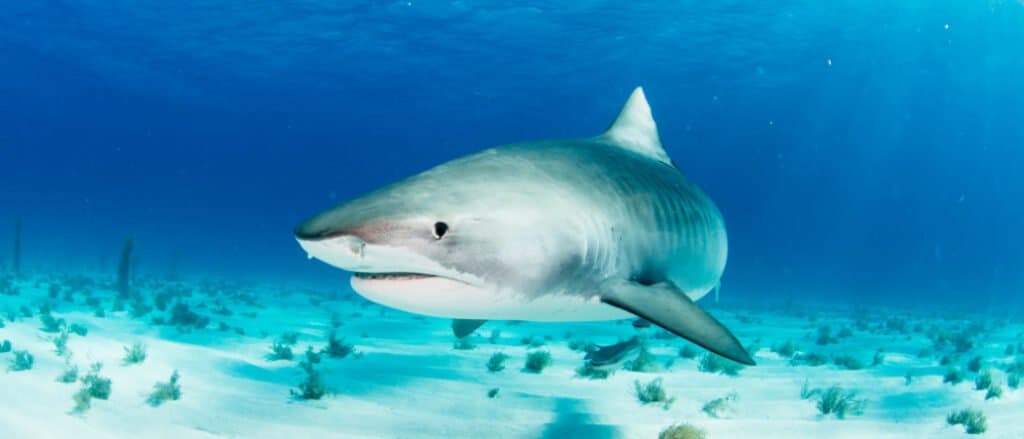
Tiger sharks are one of the predators of the bottlenose dolphin.
©Yoshinori/Shutterstock.com
Reproduction, Babies, and Lifespan
Like many mammals, the female bottlenose dolphin has a period of estrous, when she’s able to become pregnant. Sometimes a group of males will look for a female who is ready to mate, while other males pursue females singly. They don’t stay together after mating, and the bulk of childcare is left to the mother. Male bottlenose dolphins are bulls, females are cows, and their babies are calves.
Females are mature when they’re about five to 10 years old, while males are mature when they are between eight and 13. However, as with humans, it may be a long time between the time a bottlenose dolphin becomes sexually mature and when it reproduces. Some, for example, don’t reproduce until they’re about 20.
Females are pregnant for about a year, and they only have one calf at a time. The mother helps the baby to the surface so it can take its first breath. She’ll nurse her calf for about 18 to 20 months, then become pregnant again after it is weaned. The calf stays with its mother until it’s about five years old. As with humans, dolphin babies are born all year round, but most are born during the summer months. A female bottlenose dolphin can give birth throughout her life, and a group of females will help raise each other’s calves.
The average lifespan of a wild bottlenose dolphin is about 25, while a dolphin in captivity can live for over 50 years. Females tend to live longer than males, and the oldest dolphin on record was a captive female who lived to be 53.

©iStock.com/NaluPhoto
Population – How Many Bottlenose Dolphin are Left?
There are about 600,000 common bottlenose dolphins around the world, and their conservation status is LC or “Least Concern.” The animal is protected by several agreements, including the Convention on the Conservation of Migratory Species of Wild Animals, the Memorandum of Understanding Concerning the Conservation of the Manatee and Small Cetaceans of Western Africa and Macaronesia and the United States Marine Mammal Protection Act of 1972.
While the common bottlenose dolphin is classified as “Least Concern,” with only an estimated 150 individuals found in a small area on Australia’s southern coast, the recently identified Burrunan species of bottlenose dolphin may be protected in the future.

There are about 600,000 common bottlenose dolphins around the world, and their conservation status is LC or “Least Concern.”
©Tory Kallman/Shutterstock.com
Bottlenose Dolphin Facts
A killer whale and a dolphin mating?
When a male false killer whale and a female bottlenose dolphin mate, the resulting hybrid animal is named a “wholphin.” This mating is possible because while false killer whales have the term “whale” in their common name, they’re more closely related to bottlenose dolphins. While wholphins have been observed mostly in captivity, they have also been seen in the wild.
It’s believed dolphins can speak their own language!
Some scientists even believe that they have a language, as opposed to calls and sounds other herd animals make to warn of danger or draw attention to food. But what sort of language the bottlenose dolphin speaks has yet to be deciphered.
Part of the difficulty in studying the communications of bottlenose dolphins is their frequency characteristics are much different than human hearing. The bottlenose dolphin is far from the only dolphin species to have observed language. For a longer discussion, you can read our page on dolphins!
How can bottlenose dolphins nod yes?
One of the things that makes bottlenose dolphins attractive to humans is that they can move its neck and make nodding motions as if it understands what it’s being told. This is because most of the neck vertebrae aren’t fused like they are in other kinds of dolphins.
Bottlenose dolphins came from a … dog-sized animal on land?
Millions of years ago, the ancestor of the dolphin was a dog-sized animal that walked on land. Over time, it adopted a wholly aquatic lifestyle, and its body morphed into the shape of a fish. Its hind legs receded, its tail developed flukes and its front legs turned into flippers. It lost its external ears and developed a fin on its back. Its nostrils migrated from the front of its face to the top of its head so the animal can breathe without having to raise its whole head out of the water. The nostril, now called a blow-hole, snaps shut automatically when the dolphin submerges and automatically opens up when it surfaces.
Bottlenose dolphins sleep by turning off half their brains!
For a long time, people wondered how dolphins could sleep when they had to surface for air every minute or so. The amazing discovery was that one half of their brain sleeps while the other half stays awake enough to allow them to surface, breathe, and watch for predators and threats. Its brain cycles between the halves of its brain resting in two-hour periods so it can rest both halves!
Bottlenose dolphins have been observed socializing and cooperating with other species
Dolphins have been monitored swimming together with the same group of false killer whales in locations that can range hundreds of miles away. The groupings appear not to be encountered, but the species intentionally socialize and cooperatively hunt in large groups.
Other examples of dolphins cooperating with other species include dolphins that have learned to hunt with local fishermen. In 2011 researchers even discovered a group of sperm whales had adopted a bottlenose dolphin with a spinal deformity!
Dolphins are used by militaries for their advanced intelligence and echolocation
Bottlenose dolphins are the main animals used by the U.S. Navy for its “Marine Mammal Program.” The bottlenose dolphin is reported to be better at any machine in detecting mines. They’ve been used for tasks ranging from identifying old mines left over from World War II to guarding nuclear weapons off the coast of Washington State.
View all 285 animals that start with BBottlenose Dolphin FAQs (Frequently Asked Questions)
Are bottle nosed dolphin carnivores, herbivores, or omnivores?
Bottlenose dolphins are carnivores. This means that they eat meat, and since they are aquatic, the meat comes in the form of fish and marine invertebrates. Dolphins who live inshore might eat fish that are found there such as spots and croakers. They’ll also take clams, crabs, shrimp and other mollusks. Those who live in the deeper waters dine on squid and ocean fish such as pandoras.
How does a bottlenose dolphins eat?
Since dolphins prefer to eat their prey whole, they usually choose those that are between 2 and 12 inches long. If the prey is too big to swallow, the dolphin shakes it till it breaks into pieces or bashes it with their flukes. This is known, appropriately, as fish whacking. Most dolphins eat about 10 to 35 pounds a day, though a female who is nursing must eat more than this to fulfill her needs as well as her baby’s.
Bottlenose dolphins also engage in strand feeding. This is a practice where they trap shoals of fish and even strand themselves to get at them while they flop around on the shore. Some Australian bottlenose dolphins have been seen to put sponges on their beaks to protect them as they bottom feed.
How much do bottlenose dolphins weigh?
While the average weight of bottlenose dolphins ranges from 300 to 1400 pounds (135 to 635 kg), the largest bottlenose dolphins are found at the northern limits of their range. Dolphins off the cold waters of Scotland are reported to be the largest dolphins in the world. Males in general are significantly larger than females.
How fast can bottlenose dolphins swim?
Believe it or not, but how fast dolphins can swim has been a question that puzzled researchers for more than 8 decades! Bottlenose dolphins have been observed swimming in bursts of 22 miles per hour. The speed at which dolphins could swim became known as “Gray’s paradox” because it seemed to defy the limits of physics. Relative to their weight and the drag from water, bottlenose dolphins swam faster than seemed possible through physics.
However, in 2014 researchers finally discovered what allowed bottlenose dolphins to swim the fast. The answer lies in how the bottlenose dolphin can control the rigidness of its tail to effectively make it similar to “wings” – giving the dolphin extremely high efficiency gliding through the water!
What Kingdom do Bottlenose Dolphins belong to?
Bottlenose Dolphins belong to the Kingdom Animalia.
What phylum do Bottlenose Dolphins belong to?
Bottlenose Dolphins belong to the phylum Chordata.
What class do Bottlenose Dolphins belong to?
Bottlenose Dolphins belong to the class Mammalia.
What family do Bottlenose Dolphins belong to?
Bottlenose Dolphins belong to the family Delphinidae.
What order do Bottlenose Dolphins belong to?
Bottlenose Dolphins belong to the order Cetacea.
What genus do Bottlenose Dolphins belong to?
Bottlenose Dolphins belong to the genus Tursiops.
What type of covering do Bottlenose Dolphins have?
Bottlenose Dolphins are covered in Smooth skin.
In what type of habitat do Bottlenose Dolphins live?
Bottlenose Dolphins live in warm harbors and bays.
What is the main prey for Bottlenose Dolphins?
Bottlenose Dolphins prey on fish, shrimp, and squid.
What are some predators of Bottlenose Dolphins?
Predators of Bottlenose Dolphins include humans, sharks, and killer whales.
What are some distinguishing features of Bottlenose Dolphins?
Bottlenose Dolphins have large dorsal fins and communicate using whistling.
How many babies do Bottlenose Dolphins have?
The average number of babies a Bottlenose Dolphin has is 1.
What is an interesting fact about Bottlenose Dolphins?
Bottlenose Dolphins stay in groups from 15 to 2,000 in number!
What is the scientific name for the Bottlenose Dolphin?
The scientific name for the Bottlenose Dolphin is Tursiops Truncatus.
What is the lifespan of a Bottlenose Dolphin?
Bottlenose Dolphins can live for 20 to 35 years.
How to say Bottlenose Dolphin in ...
Thank you for reading! Have some feedback for us? Contact the AZ Animals editorial team.
Sources
- David Burnie, Dorling Kindersley (2011) Animal, The Definitive Visual Guide To The World's Wildlife
- Tom Jackson, Lorenz Books (2007) The World Encyclopedia Of Animals
- David Burnie, Kingfisher (2011) The Kingfisher Animal Encyclopedia
- Richard Mackay, University of California Press (2009) The Atlas Of Endangered Species
- David Burnie, Dorling Kindersley (2008) Illustrated Encyclopedia Of Animals
- Dorling Kindersley (2006) Dorling Kindersley Encyclopedia Of Animals
- David W. Macdonald, Oxford University Press (2010) The Encyclopedia Of Mammals
- Joe Roman, Available here: https://slate.com/technology/2013/01/fishing-with-dolphins-symbiosis-between-humans-and-marine-mammals-to-catch-more-fish.html
- Will Worley, Available here: https://www.independent.co.uk/news/science/dolphins-speak-language-human-communication-scientists-a7237791.html
- Kate Charlton-Robb, Available here: https://www.monash.edu/news/articles/2443









